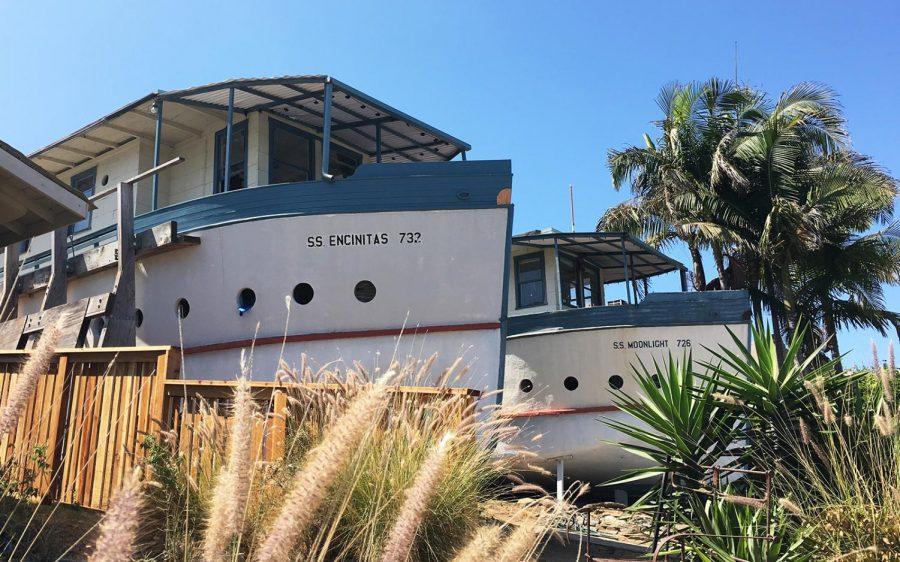National historic status on horizon for Encinitas Boat Houses
The Encinitas Boat Houses, pictured Aug. 23, are on track to be included on the National Register of Historic Places. (Photo by Roman S. Koenig)
August 23, 2019
The Encinitas Boat Houses, the most photographed buildings in the city, are on their way to earning a spot on the National Register of Historic Places following a vote by the State Historical Resources Commission on Aug. 1.
The State Historical Resources Commission approved the Boat Houses for historic status at its last meeting in August and the buildings are now on the California Register of Historic Places, said Alan Hess, one of the nine commissioners on the board.
Hess said the board forwards each nomination to the National Register in Washington, D.C., which has its own process for approving nominations. However, he added, once a location is approved by the State Historical Resources Commission, it oftentimes is also placed on the National Register, usually about a month to six weeks later.
Sean Englert, vice president of the Encinitas Preservation Association and former president of the Encinitas Historical Society, said preparations are underway for a celebration on Oct. 12 to unveil a plaque memorializing the placement of the Boat Houses on the National Register.
Englert, who worked to finalize and submit the application for the historic status, said he was proud to be able to get the process to the finish line for the Preservation Association and the community.
“I know how much it means to the community,” he said. “And it’s very exciting that now that we have this designation, that (the Boat Houses are) going to be protected here on out in the future.”
He added that he thinks the Boat Houses symbolize the free-spirited entrepreneurial visions of their creator, Miles Kellogg.
“I think when you look back in the late ’20s (and) ’30s, there was a lot of these really unconventional monuments throughout Southern California that were placed for the California dream, and I just think it fits so well with down here and the passion and the energy of Encinitas.”
Hess said the Boat Houses were approved by the State Historical Resources Commission based on their architecture, which he referred to as programmatic architecture, or architecture that looks like something other than a building.
There are numerous examples of programmatic architecture in California, such as the Brown Derby restaurant in Hollywood, which was shaped like a derby hat, Hess said. He added that these buildings appeared in California as the automobile became more widespread and commercial buildings used such fantastic shapes to attract attention.
“There’s a whole history of that, especially in California,” Hess said. “This sort of architecture was nationwide, but in California, there was a spirit of openness (and) freedom. You could do whatever you wanted to do here. There weren’t the restrictions and codes that made people more conservative back east.”
Hess said he thinks the nomination of the Boat Houses to the National Register brought out a lot of community spirit from the city.
“These boat houses are a real landmark in Encinitas,” he said. “People have known them all their lives and enjoy them and wanted them to be recognized. And it’s always great to see architecture appreciated on a local grassroots level that way.”
The Boat Houses were originally built in the 1920s by Kellogg from recycled lumber from a bath house and dance hall on Moonlight Beach, said Lois Aufmann, a docent at the Encinitas Historical Society.
However, Kellogg, who was from a shipbuilding family in Michigan, never meant for the Boat Houses to go out to sea, Aufmann said.
“It was not for any other purpose other than to have a unique place that was a place to live,” she said. “They were never meant to be seaworthy. They were always built to be a residence.”
As property by the beach has gotten more expensive over the past 20 to 30 years, it’s been lucrative for developers to level homes near the beach and build duplexes, Aufmann said, adding that she thinks this could have happened to the Boat Houses.
Former owners of the Boat Houses wanted to sell the property in 2008, which could have bode ill for the buildings, Aufmann said. However, the Encinitas Preservation Association was able to purchase the houses instead.
Aufmann said she thinks the appreciation everyone in Encinitas has for the Boat Houses is what helped save them.
“I think the owners over the years (and) everybody has appreciated their uniqueness,” she said. “And I think that’s the only thing that has really saved them.”
Kellie Shay Hinze, an Encinitas City Council member, similarly said she thinks the community members are what helped the Boat Houses move toward earning a spot on the National Register.
“It’s only happened because a really devoted group of community members came together, and on their volunteer time, to make that happen,” she said.
Hinze said she remembers visiting the Boat Houses on field trips and drawing them in class when she attended Pacific View Elementary School, which was just around the corner from the buildings.
She added that she thinks the Boat Houses represent the character of Encinitas particularly well.
“The materials that the boat houses are made of are totally repurposed from other buildings that probably would have just been thrown away if it hadn’t been for the ingenuity of architect Miles Kellogg,” Hinze said. “And I think that’s sort of a testament to the way that we still seek to live in Encinitas today … And it’s a certain kind of ingenuity that I think that we really admire in our community character.”
Encinitas Mayor Catherine Blakespear said in an email statement that she is proud of the efforts made by the Encinitas Preservation Association over the past 12 years to preserve the Boat Houses.
“(Miles Kellogg’s) creative legacy of the S.S. Encinitas and S.S. Moonlight boathouses will live on forever with this latest designation on the National Registry of Historic Places,” Blakespear stated. “Congratulations to everyone involved with obtaining this great honor.”
Julia Shapero is an Encinitas freelance writer




